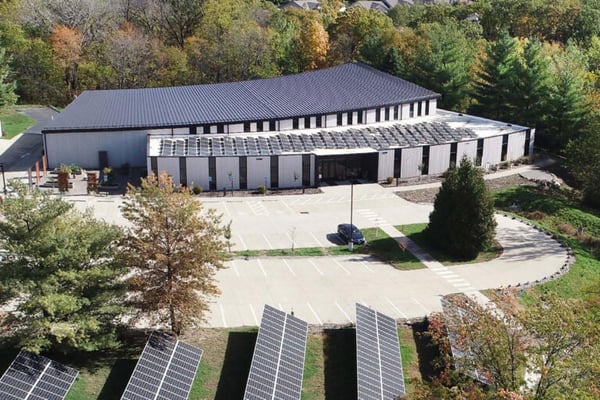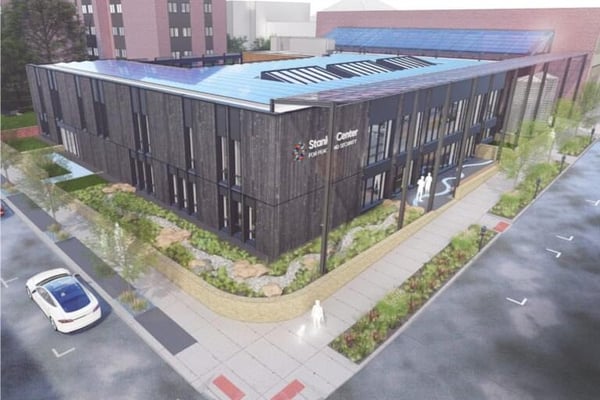Cost is often a major concern for anyone considering solar power. Although the price of solar panels has decreased in recent years, they are still a sizable investment. Thankfully, the solar industry has numerous financing options to fit different budgets and project types.
At Neumann Monson, we have helped several clients explore solar financing. While some choose to pay for solar panels outright, others use monthly financing methods. Each method has its benefits and drawbacks, and the right fit depends on your budget and goals.
To help you determine which option fits your needs, this article will discuss the pros and cons of upfront and monthly financing and provide a broad overview of your options in each category.
Upfront vs. Monthly Payments for Solar Panels
Like other major purchases, you can either pay for solar panels all at once or over time through monthly payments.
In most cases, upfront payments are the most cost-effective. The upfront cost of a solar array is often much lower than the long-term cost of monthly financing. This is especially true for private organizations that can take advantage of tax credits when purchasing panels.
Many do not have the initial capital for an upfront purchase—making monthly payments the only viable option. Some monthly financing options allow you to work toward full ownership of your solar system. Others allow you to pay for the electricity your panels produce, often at a cost lower than a typical utility bill. Regardless of the financing method you choose, you will likely benefit from reduced utility costs in the long run.
Monthly Options
The two most common monthly financing options are Power Purchase Agreements and Capital Leases.
Power Purchase Agreement (PPA)
A Power Purchase Agreement (PPA) is a contractual agreement between a solar provider and the building owner. The solar provider owns the panels and covers the cost of installation and ongoing maintenance. The building owner, in turn, pays for the generated electricity at a kilowatt-per-hour rate.
Generally, the monthly cost of a PPA is less expensive than a monthly utility bill, though your savings depend on the cost of electricity in your area. If energy costs are already low in your area, you are less likely to notice a dramatic saving from a PPA.
The length of the contractual agreement will vary, but generally, PPAs last for a long-term period of 10-20 years. If you move locations during your contract period, you can usually work with the solar provider to transfer the PPA to the new building owners.
Often, nonprofits that cannot take advantage of tax credits utilize PPAs. For example, the Unitarian Universalist Society used a PPA to finance the solar array at their new facility in Coralville, IA.

Unitarian Universalist used a PPA to finance its solar array.
Capital Lease
With a Capital Lease, you make monthly payments on the panels themselves, rather than the electricity they produce. This option allows you to finance your system without upfront capital.
Unlike a PPA, you are usually responsible for the ongoing maintenance of the system. Once you pay off the lease, you will have full ownership over your solar panels, and you can reap the benefits of utility savings.
Upfront Options
If you are interested in purchasing your panels upfront, you are not limited to cash payments. The solar industry has several options that accommodate the needs of different industries and building types.
Cash payments are most popular with private organizations, like developers and businesses. By using this method, they can qualify for a federal tax credit. This method was used to finance the solar arrays at Market One in Des Moines, IA.
Organizations that cannot take advantage of tax credits can either use a Prepaid PPA or a Solar Power Agreement (SPA).
Prepaid PPA
Prepaid PPAs are an attractive option for organizations that cannot receive tax credits, like non-profits. Like a monthly PPA, the solar provider owns the panels and covers the cost of installation and ongoing maintenance.
The building owner pays for the electricity through a one-time, upfront payment. Often, the price is at a discounted rate because the provider can take advantage of tax credits. Since the solar provider covers maintenance, this option works well for organizations who want to go green without the risks of ownership.
Solar Power Agreement (SPA)
Solar Power Agreements (SPAs) can be thought of as a hybrid model. They allow nonprofits to benefit from federal tax credits, while also maintaining long-term ownership of their solar system. Here’s how it works:
The solar provider purchases the panels and receives a tax credit before selling the panels to the building owner at a discounted rate. The provider covers the cost of installation and maintenance and owns the system for a short period, usually six years.
After the specified period ends, the solar provider transfers ownership to the building owner. In short, this method allows nonprofits that cannot receive tax credits to work toward full ownership of their solar system.
The Stanley Center for Peace and Security—which needs to produce 105% of its energy needs through solar power to meet the requirements of the Living Building Challenge—will use this method. After exploring several options, the SPA was the most cost-effective way to finance the large number of solar panels the project requires.

Rendering of the Stanley Center for Peace and Security, which will use an SPA.
An Evolving Industry
Solar power is becoming increasingly popular, and the solar industry is creating new financing options to keep up with demand. At the same time, the price of solar panels is constantly changing. Federal tax credits are being phased out for both commercial and residential projects, dropping to just 22% in 2024.
Financing options are likely to change over the next several years. If you are considering solar panels, get quotes from several solar providers and explore your options.
What Are Your Next Steps?
Solar panels can help you reach your sustainability goals and decrease the long-term costs of building ownership. Upfront payments are often the most cost-effective, especially if you can receive federal tax credits. If you do not have the upfront capital, you can use a monthly financing option, like a PPA or a Capital Lease.
An architect can help you determine which option fits your needs. Before contacting vendors, we perform a preliminary feasibility analysis of the site, the size of the solar array, and the cost. We then help our clients write an RFP, contact solar providers, and compare quotes, so they get the greatest value for their dollar. To learn what it’s like to work with us, contact us, and start a conversation with an architect.
Want to learn more? Read how you can improve your project’s sustainability at no-added project cost.
